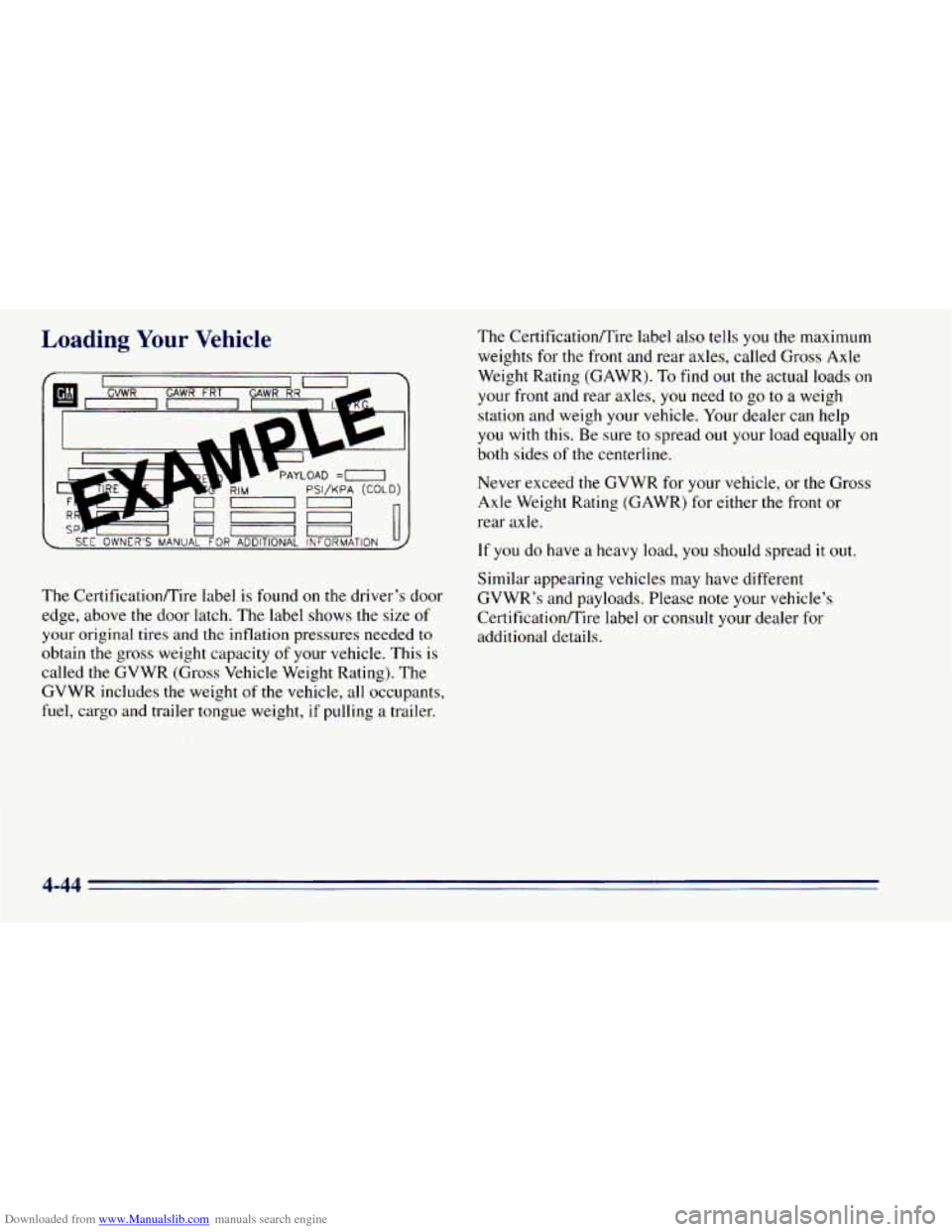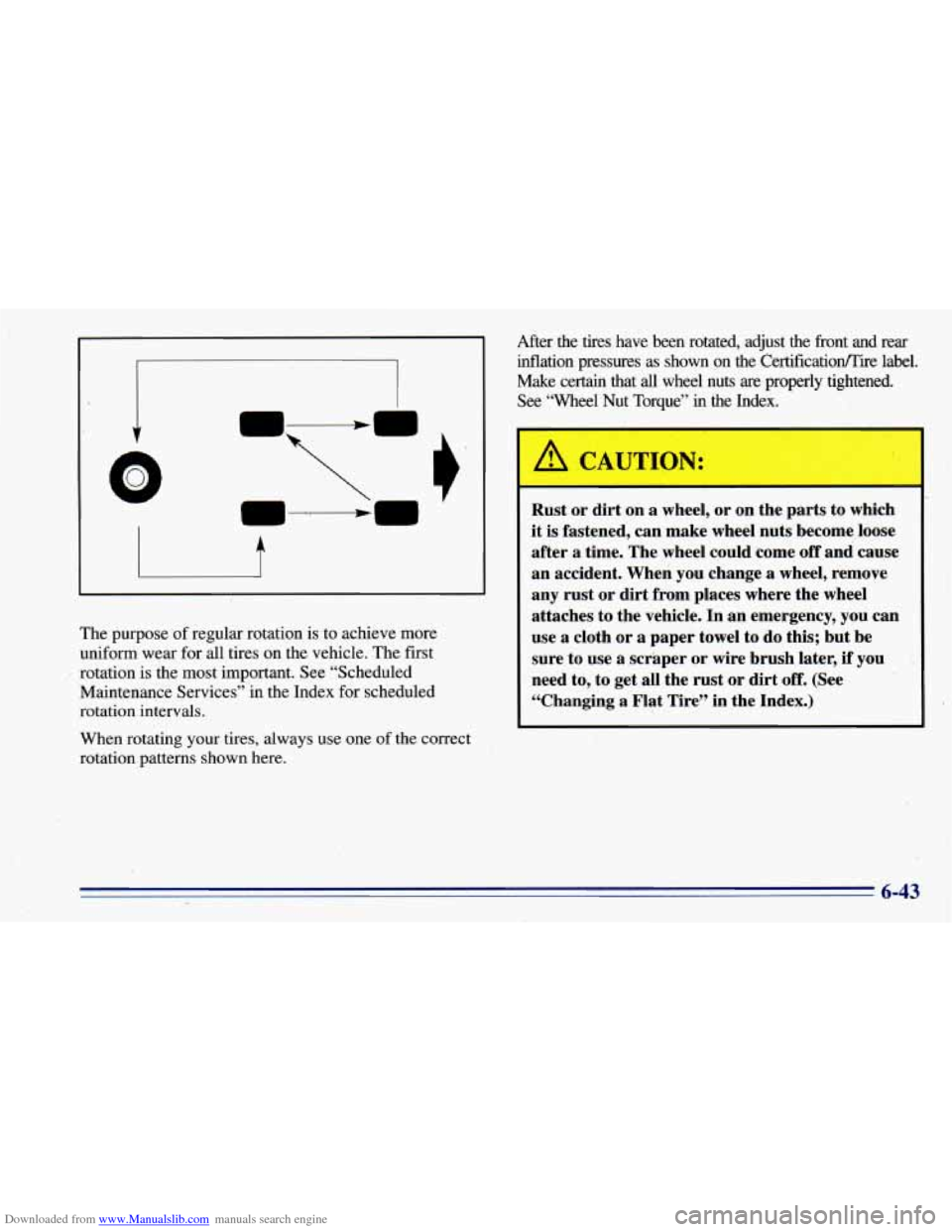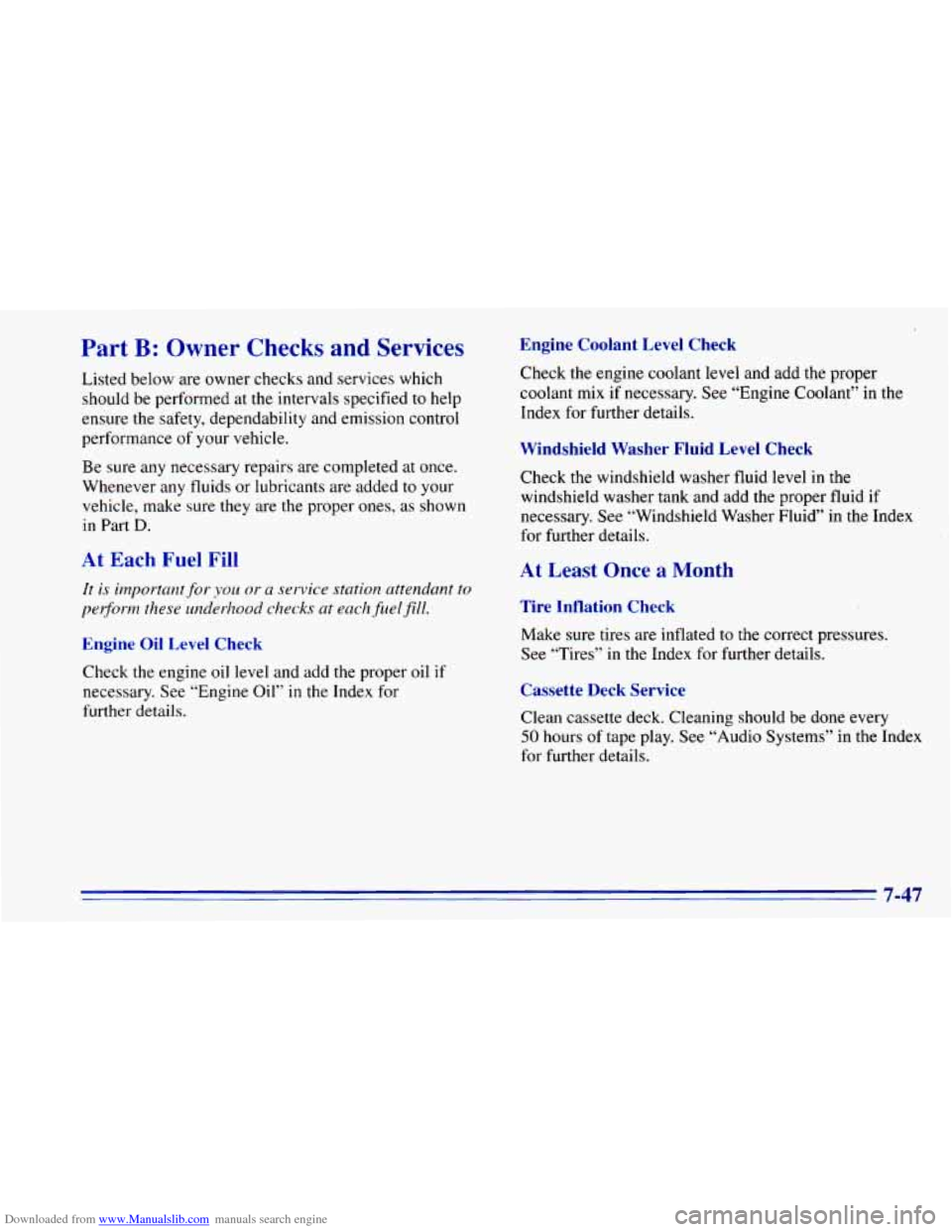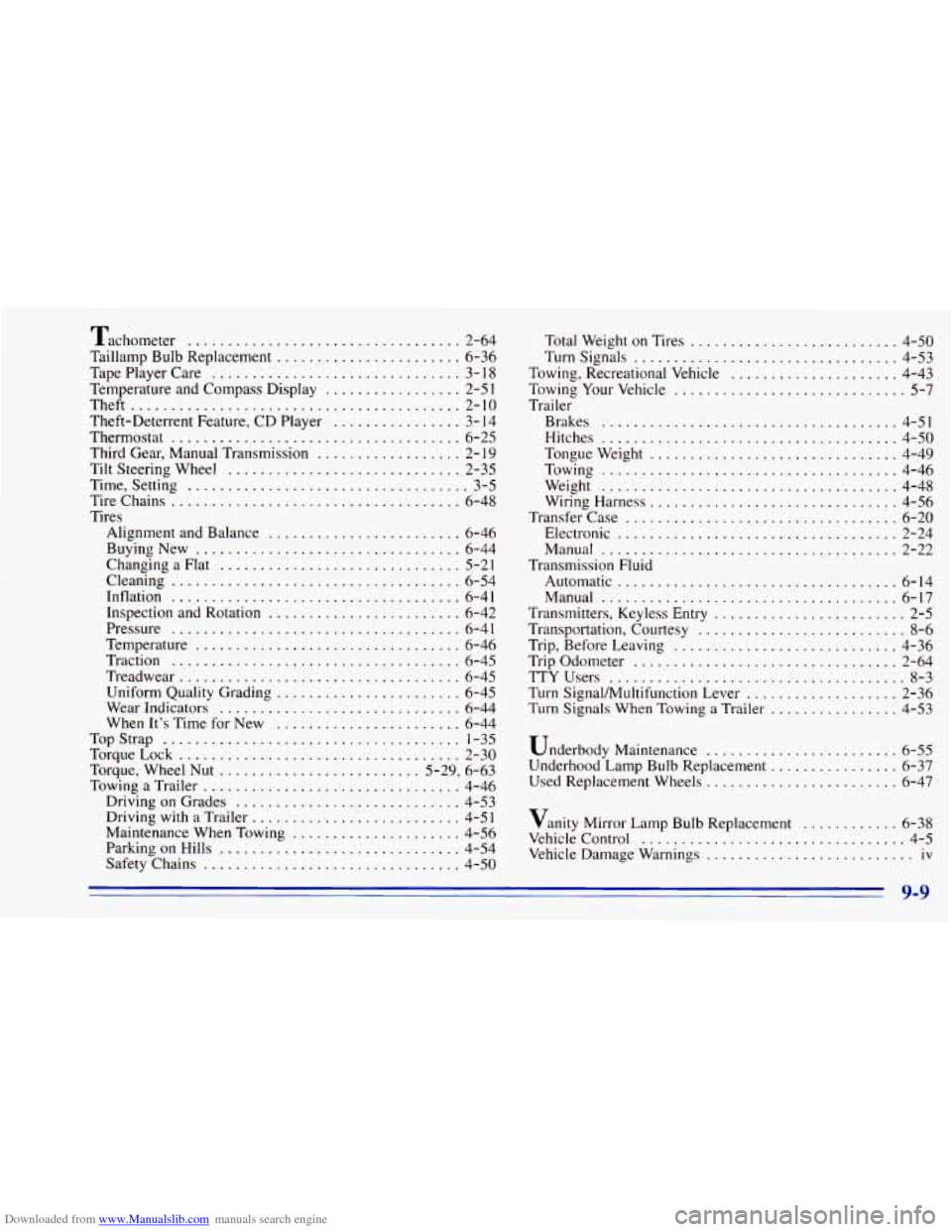1996 CHEVROLET BLAZER inflation pressure
[x] Cancel search: inflation pressurePage 198 of 392

Downloaded from www.Manualslib.com manuals search engine Loading Your Vehicle
I *
‘GVWR VR F I
PAYLOAD =-I
PSI/KPA (COL
n
SEE OWNER’S MANUAL FOR ADDITIONAL INFORMATION I U
The Certificationnire label also tells you the maximum
weights for the front and rear axles, called Gross Axle
Weight Rating (GAWR). To find out the actual loads on
your front and rear axles, you need to go to a weigh
station and weigh your vehicle. Your dealer can help
you with this. Be sure to spread out your load equally on
both sides
of the centerline.
Never exceed the GVWR for your vehicle, or the Gross
Axle Weight Rating (GAWR) for either the front or
rear axle.
If you do have a heavy load, you should spread it out.
Similar appearing vehicles may have different
The Certificationrrire label is found on the driver’s door GVWR’s and payloads. \
Please note your vehicle’s
edge, above the door latch. The label shows the size of Certificationnire label or consult your dealer for
your
original tires and the inflation pressures needed to additional details.
obtain
the gross weight capacity of your vehicle. This is
called
the GVWR (Gross Vehicle Weight Rating). The
GVWR includes the weight of the vehicle, all occupants,
fuel, cargo and trailer tongue weight,
if pulling a trailer.
4-44
Page 289 of 392

Downloaded from www.Manualslib.com manuals search engine Poorly maintained and im
are dangerous. operly
used tires
0
0
0
0
Overloading your tires can cause
overheating
as a result of too much friction.
You could have an air-out and a serious
accident. See “Loading Your Vehicle” in
the Index.
Underinflated tires pose the same danger as
overloaded tires. The resulting accident
could cause serious injury. Check all tires
frequently to maintain the recommended
pressure. Tire pressure should be checked when your tires are cold.
Overinflated tires are more likely
to be
cut, punctured or broken by a sudden
impact
-- such as when you hit a pothole.
Keep tires at the recommended pressure.
Worn, old tires can cause accidents.
If your
tread
is badly worn, or if your tires have
been damaged, replace them.
Inflation - Tire Pressure
The Certificationmire label which is on the driver’s door
edge, above the door latch, shows the correct inflation
pressures for your tires
when they’re cold. “Cold”
means your vehicle has been sitting for
at least three
hours or driven
no more than a mile.
NOTICE:
Don’t let anyone tell you that underinflation or
overinflation is all right. It’s not.
If your tires
don’t have enough air (underinflation), you can
get the following:
0 Too much flexing
Too much heat
0 Tire overloading
0 Bad wear
Bad handling
Bad fuel economy.
NOTICE: (Continued)
6-41
Page 290 of 392

Downloaded from www.Manualslib.com manuals search engine NOTICE: (Continued)
If your tires have too much air (overinflation),
you can get the following:
Unusual wear
Bad handling
Rough ride
Needless damage from road hazards.
When
to Check
Check your tires once a month or more. Also, check the
tire pressure of the spare tire.
How to Check
Use a good quality pocket-type gage to check tire
pressure. You can’t tell if your tires are properly inflated
simply by looking at them. Radial tires may look
properly inflated even when they’re underinflated.
Be sure to put the valve caps back
on the valve stems.
They help prevent leaks by keeping
out dirt and moisture.
Tire Inspection and Rotation
Tires should be inspected every 6,000 to 8,000 miles
(10 000 to 13 000 km) for any signs of unusual wear., If
unusual wear is present, rotate your tires as soon as
possible and check wheel alignment. Also check for
damaged tires or wheels. See “When It’s Time for New
Tires” and “Wheel Replacement” later
in this section for
more information.
6-42
Page 291 of 392

Downloaded from www.Manualslib.com manuals search engine c
f
The purpose of regular rotation is to achieve more
uniform wear for all tires on the vehicle. The first
Maintenance Services” in the Index for scheduled
rotation intervals.
I rotation is the most important. See “Scheduled
When rotating your tires, always use one of the correct
rotation patterns shown here. After the tires have been rotated, adjust the front and rear
inflation pressures as shown on the
Certificatioflire label.
Make certain that
all wheel nuts are. properly tightened.
See “Wheel Nut Torque’’
in the Index.
Rust or dirt on
a wheel, or on .the parts to Which
it is fastened, can make wheel nuts become loose
after
a time. The wheel could come off and cause
an accident. When you change
a wheel, remove
any rust or dirt from places where the wheel
attaches to the vehicle. In an emergency, you can
use
a cloth or a paper towel to do this; but be
sure to use
a scraper or wire brush later, if you
need to, to get all the rust or dirt
off. (See
“Changing
a Flat Tire” in the Index.)
-_
6-43
Page 359 of 392

Downloaded from www.Manualslib.com manuals search engine Part B: Owner Checks and Services
Listed below are owner checks and services which
should be performed at the intervals specified to help
ensure the safety, dependability and emission control
performance of your vehicle.
Be sure any necessary repairs are completed at once.
Whenever any fluids or lubricants are added to your
vehicle, make sure they are the proper ones, as shown
in Part D.
At Each Fuel Fill
It is important for you or a service station attendant to
perform these underhood checks
at each fuel fill.
Engine Oil Level Check
Check the engine oil level and add the proper oil if
necessary. See “Engine Oil” in the Index for
further details.
Engine Coolant Level Check
Check the engine coolant level and add the proper
coolant mix if necessary. See “Engine Coolant” in the
Index for further details.
Windshield Washer Fluid Level Check
Check the windshield washer fluid level in the
windshield washer tank and add the proper fluid if
necessary. See “Windshield Washer Fluid” in the Index
for further details.
At Least Once a Month
Tire Inflation Check
Make sure tires are inflated to the correct pressures.
See “Tires”
in the Index for further details.
Cassette Deck Service
Clean ca :tte deck. Cleaning should be done every
50 hours or tape play. See “Audio Systems” in the Index
for further details.
7-47
Page 389 of 392

Downloaded from www.Manualslib.com manuals search engine Tachometer ................................ 2-64
Taillamp Bulb Replacement
....................... 6-36
TapePlayerCare
............................... 3-18
Temperature and Compass Display
................. 2-5 1
Theft ......................................... 2-10
Theft-Deterrent Feature. CD Player
................ 3- 14
Thermostat
.................................... 6-25
Third Gear, Manual Transmission
.................. 2- 19
Tilt Steering Wheel
.................. ....... 2-35
Time. Setting
................................... 3-5
Tire Chains
......................... ....... 6-48
Tires Alignment and Balance
........................ 6-46
Buying New
................................. 6-44
Changing
a Flat .............................. 5-21
Cleaning
.................................... 6-54
Inflation
.................................... 6-41
Inspection and Rotation
........................ 6-42
Pressure
.................................... 6-41
Temperature
................................. 6-46
Traction
.................................... 6-45
Treadwear
................................... 6-45
Uniform Quality Grading
....................... 6-45
Wear Indicators
.............................. 6-44
When It’s Time for New
....................... 6-44
TopStrap
..................................... 1-35
TorqueLock
................................... 2-30
Torque. Wheel
Nut ......................... 5-29. 6-63
Towing
a Trailer ................................ 4-46
Driving on Grades
............................ 4-53
Maintenance When Towing
..................... 4-56
Parking on Hills
.............................. 4-54
Safety Chains
................................ 4-50
Driving
with a Trailer ..................... : .... 4-5 1
Total Weight on Tires .......................... 4-50
Turnsignals
................................. 4-53
Towing. Recreational Vehicle
..................... 4-43
Towing Your Vehicle
............................. 5-7
Trailer Brakes
..................................... 4-51
Hitches
..................................... 4-50
Towing
..................................... 4-46
Weight
..................................... 4-48
Wiring Harness
............................... 4-56
Transfercase
.................................. 6-20
Electronic
................................... 2-24
Manual
............................... 2-22
Automatic
................................... 6-14
Manual
..................................... 6-17
Transmitters. Keyless Entry
........................ 2-5
Tongueweight
............................... 4-49
Transmission Fluid
Transportation, Courtesy
.......................... 8-6
Trip, Before Leaving
............................ 4-36
Trip Odometer
................................. 2-64
Turn Signal/Multifunction Lever
................... 2-36
Turn Signals When Towing
a Trailer ................ 4-53
TTYUsers
..................................... 8-3
Underbody Maintenance
........................ 6-55
Vanity Mirror Lamp Bulb Replacement
.......... 6-38
Underhood Lamp Bulb Replacement
................ 6-37
Used Replacement Wheels
........................ 6-47
Vehicle Control
................................. 4-5
Vehicle Damage Warnings
.......................... iv
9-9